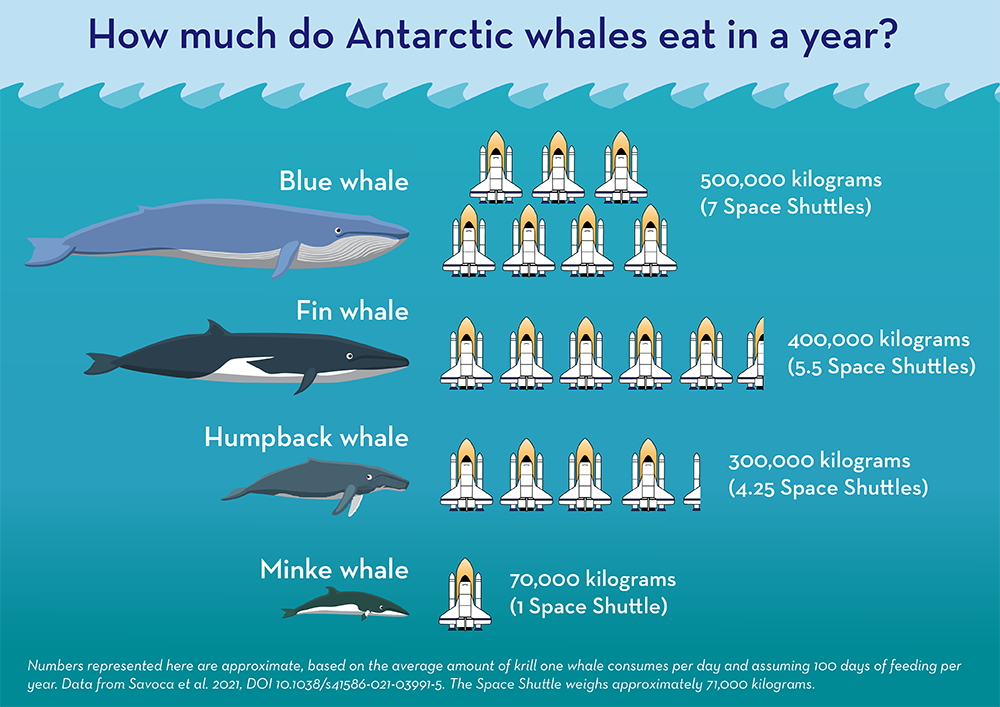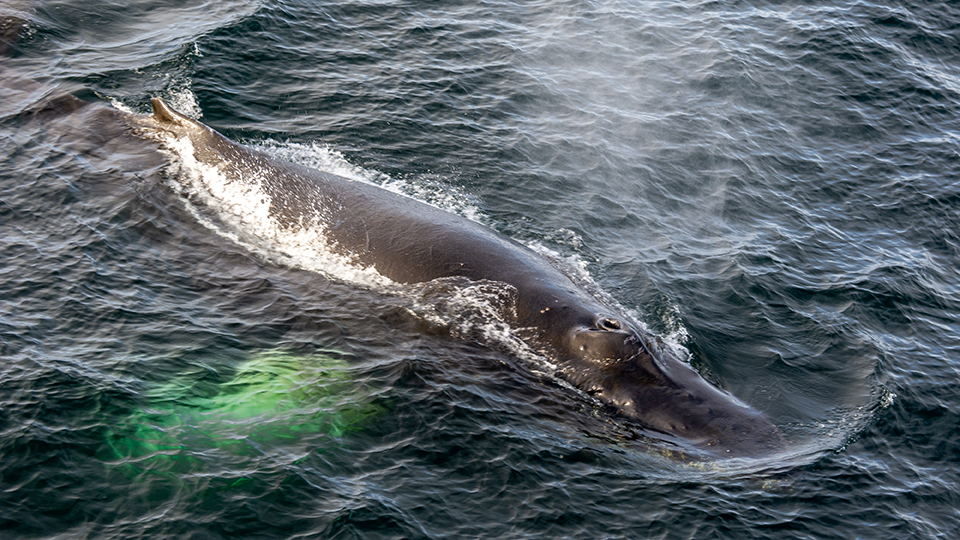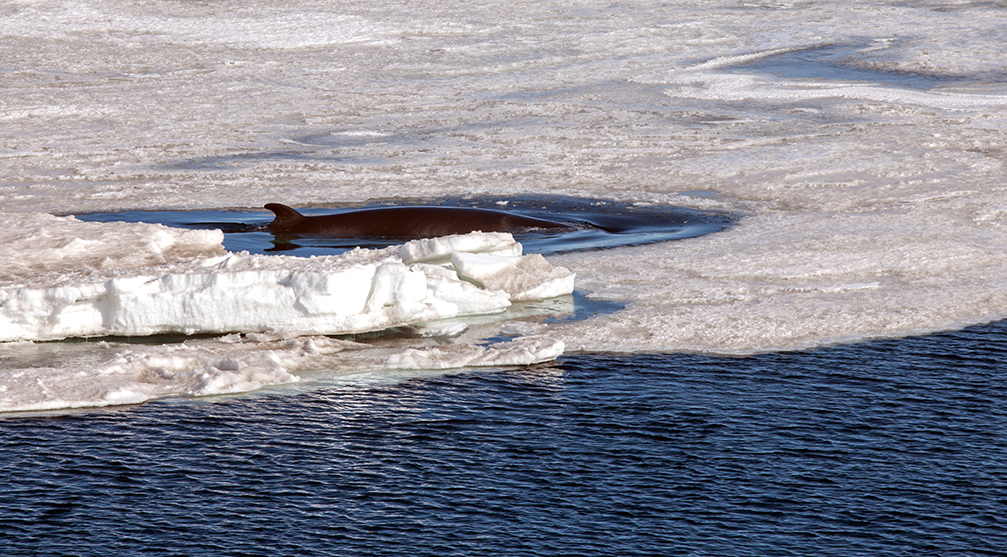Ocean giants’ appetites are larger than we thoughtBlue whales eat seven Space Shuttles worth of food every year, new research findsPosted April 11, 2022
Researchers have the best measurements yet of how much Antarctic whales eat, results that help them understand a strange ocean food paradox they've observed since the whaling era ended. A recent study quantifies how much food baleen whales - the largest creatures on Earth - consume on a given day. The results show that overall, baleen whales consume more food than biologists previously thought. 
Graphic by Lauren Lipuma.
This infographic shows how much krill Antarctic whales consume in a given year.
For whales living in the waters surrounding Antarctica, the new study shows how drastically the whaling industry impacted the world's oceans. The researchers measured not only how much food baleen whales consume but also how much iron they recycle back into the ocean. Iron is an essential nutrient for living things at all levels of the food web. Around 80% (and possibly more) of Earth's baleen whales were killed during the whaling era, the vast majority coming from the Southern Ocean that surrounds Antarctica. The new study shows iron recycling by the largest Antarctic whales is almost nonexistent today because so few of them are left. With less iron available in the ocean, populations of krill, baleen whales' preferred food, have not rebounded since the whaling era ended as scientists expected they would. The results show just how important whales are to their ecosystems and how much the ocean could benefit from allowing whale populations to recover, according to the study authors. “It's the first kind of data-informed estimate that confirms the amount that these whales eat is immense, and if anything, for the Antarctic has been underestimated,” said Matthew Savoca, a biologist with Hopkins Marine Station at Stanford University and lead author of the new study. “We're excited to be able to actually support those statements with evidence, and hopefully use them to encourage the conservation of the Southern Ocean.” An ocean giant's dietBaleen whales, which include blue, fin, humpback, and minke whales, are the largest living creatures on Earth. Blue whales, the heftiest of the group, can grow up to 110 feet long and weigh as much as a house. Baleen whales are not just the largest animals that exist today: they're the biggest mammals to exist ever. Scientists have long been fascinated with how these ocean behemoths grew to be so massive, so for over a century they've been trying to estimate how much food the gentle giants consume. Baleen whales eat mostly krill, golf-tee sized crustaceans. The whales are filter feeders who take enormous gulps of ocean water filled with swimming krill and filter the tiny crustaceans through bristle-like combs called baleen in their upper jaws. Some baleen whales can open their jaws 90 degrees wide while feeding, and their throat pouches can expand to be larger than the whale itself. Savoca was initially interested in figuring out how much plastic contamination whales ingest, but he soon realized there was a more basic question to be answered: how much a baleen whale eats in a given year. In the past, biologists estimated how much food whales consume using two methods. They weighed the stomach contents of whale carcasses and used metabolic models to estimate how much food an animal of that size needs to maintain its weight. But neither of these methods was accurate, and with new technologies now available, Savoca decided to see if he could get a more precise estimate. In the new study, Savoca and his colleagues combined three types of measurements to estimate whale food consumption. They used data from suction-cup tags attached to individual whales that track a whale's movement, position, and orientation in the water - what Savoca calls a whale Fitbit. The tags tell researchers how often the whales are diving for food, among other things. They also used drone images of feeding whales to measure the size of their throat pouches, or how much water they're consuming every mouthful. And they used a kind of sonar to estimate how many krill are present in the water the whales gulp down. The effects of whalingDuring the whaling era, which started around the 11th century and continued until the mid-20th century, sailors from many different countries hunted whales for their valuable blubber. The blubber was rendered to make oil for lighting and later used to make glycerin for explosives. Commercial whalers stalked the animals throughout Earth's oceans, going as far as the Southern Ocean around Antarctica. Some species were hunted nearly to extinction, so in the 20th century, whaling nations agreed to regulate the industry and allow whale populations to recover. In the new study, researchers collected data from more than 300 individual whales of seven different species in the Atlantic, Pacific, and Southern Oceans. They found that previous research vastly underestimated the amount of food whales consume. In the Southern Ocean alone, they calculate that before the whaling era, baleen whales collectively devoured nearly half a billion tons of krill each year, twice the total amount of krill researchers estimate to be in the ocean today. Iron is a scarce nutrient in the Southern Ocean, and whales send a huge amount of it back into the ocean food web through their feces. The new study's results show that pre-whaling, Antarctic whales recycled 10 times more iron than they do now, and today the largest whales (blue and fin) contribute almost none. One thing that has puzzled scientists is that krill populations have plummeted since the whaling era ended in the mid-20th century. Researchers thought that with so few large whales left, krill populations would have rebounded, but in fact they see the opposite. Savoca's results help resolve this conundrum: with whales recycling far less iron than they used to, there's not enough of the nutrient left in the system to support the large quantities of krill that used to exist. And without enough krill to eat, whale populations can't recover to what they were before the whaling era. “One thing that this analysis points to is I think these animals are food-limited right now,” Savoca said. The ocean giants aren't starving to death, but they may not be sufficiently healthy to have enough babies to rebuild their numbers, according to Savoca. But if humans could find a way to give whale or krill populations a boost, it would benefit the entire ocean ecosystem through that iron recycling loop. “The ecosystem, as exceptional as it is even now, is only a fragment of what it used to be, and not that long ago,” Savoca said. “I think we can live in a world where that ecosystem that was first described by scientists in the 1920s and '30s, I think we can get back there.” This research is supported by the National Science Foundation, which manages the U.S. Antarctic Program. NSF-funded research in this story: Jeremy Goldbogen, Stanford University, awards 1656691 and 1644209; Ari Friedlaender, University of California Santa Cruz, awards 1643877 and 1250208; Hugh Ducklow, Columbia University, award 1440435; and Matthew Savoca, Stanford University, award 1906332. |
"News about the USAP, the Ice, and the People"



For USAP Participants |
For The Public |
For Researchers and EducatorsContact UsU.S. National Science FoundationOffice of Polar Programs Geosciences Directorate 2415 Eisenhower Avenue, Suite W7100 Alexandria, VA 22314 Sign up for the NSF Office of Polar Programs newsletter and events. Feedback Form |



